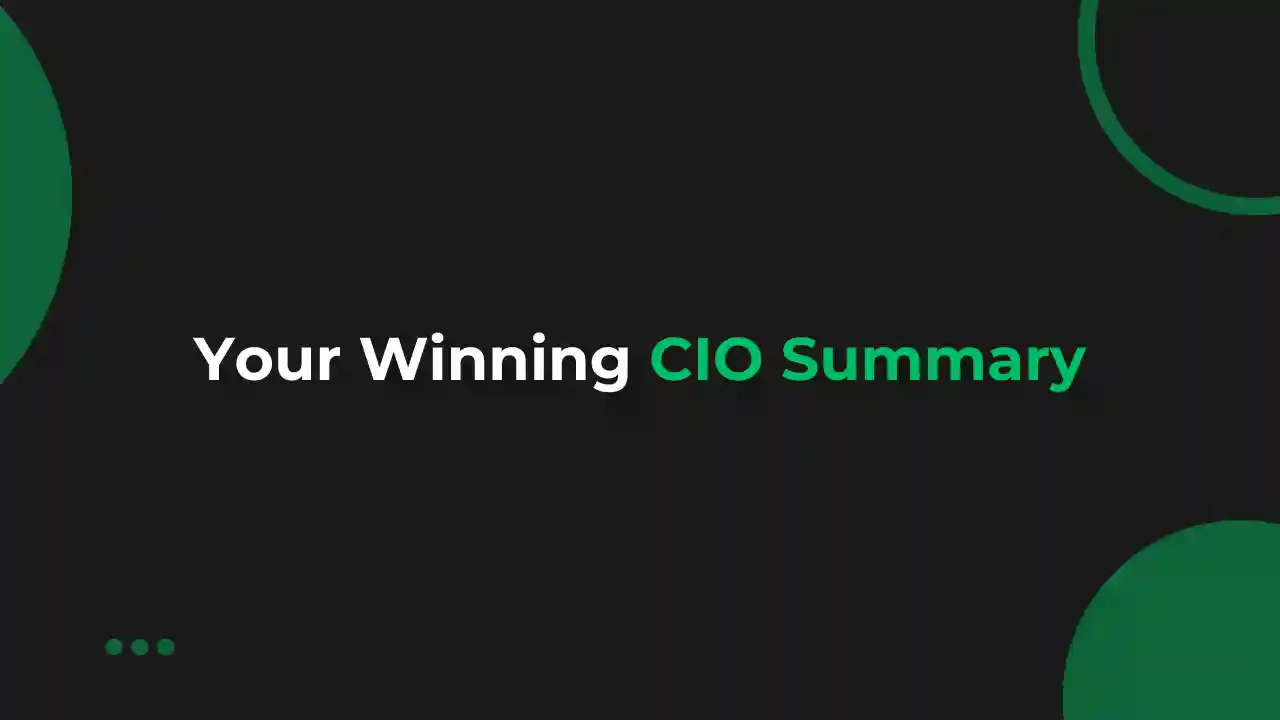Let’s be real for a second. In the fast-paced world of technology leadership, your LinkedIn profile isn’t just a digital resume; it’s your personal brand’s landing page. Especially for Chief Information Officers (CIOs), a role that bridges complex tech landscapes with crucial business strategy, how you present yourself online makes a massive difference.
Whether you’re navigating a career pivot, seeking board opportunities, or simply want to attract the right network, your LinkedIn summary is your prime real estate – your chance to make a compelling first impression in just a few sentences.
Now, thinking about writing a summary might feel like another chore on an already packed schedule filled with cybersecurity reviews and digital transformation roadmaps. But here’s the deal: a powerful summary isn’t just a list of your past jobs. It’s about articulating your unique value, your strategic vision, and the impact you’ve driven.
Read Also: CEO LinkedIn Summary Examples
It’s where you move beyond the technical specifications and showcase your leadership. In this article, we’re going to dive into some compelling CIO LinkedIn summary examples, break down the essential skills for today’s tech leader, and give you a clear roadmap for crafting your own standout summary. We’re keeping it practical, engaging, and definitely jargon-light.
Sample LinkedIn Summary Chief Information Officers
Alright, let’s get to the good stuff – seeing how other top tech leaders might frame their stories. Here are five CIO LinkedInsummary examples designed to showcase different strengths and approaches within the CIO role.
Think of these as starting points or inspiration. Feel free to mix and match elements that resonate with your own journey and leadership style.
These examples aim to highlight not just technical prowess, but the strategic, leadership, and business-centric aspects that define a modern CIO.
You’ll notice they focus on impact, vision, and the intersection of technology and organizational goals. Each one tries to capture a distinct ‘vibe’ – from the strategic partner to the transformation driver or the security champion.
1. The Strategic Business Partner Chief Information Officers
“My mission? To ensure technology isn’t just a cost center, but a powerful engine driving business growth and innovation.
As a CIO, I specialize in translating complex IT strategies into clear business outcomes, aligning technology investments directly with organizational objectives.
I’ve led digital transformations that have boosted efficiency by X%, enabled Y% revenue growth through new tech platforms, and built resilient, scalable infrastructures that support global operations.
I thrive on building bridges between IT and every other department, ensuring technology empowers teams and creates competitive advantage. Let’s connect if you’re looking for a tech leader who speaks the language of business.”
Read Also: Cracking the Code! CTO LinkedIn Summary Examples
2. The Digital Transformation & Innovation Chief Information Officers
“Navigating the future of work requires bold technology leadership. I’m a CIO passionate about harnessing the power of emerging tech – from AI and machine learning to cloud-native architectures – to fundamentally transform how businesses operate and interact with customers.
I’ve spearheaded enterprise-wide digital shifts, migrating legacy systems, implementing agile methodologies across IT, and fostering a culture of continuous innovation.
My focus is on building flexible, data-driven organizations ready to adapt to tomorrow’s challenges. If you’re ready to lead the charge into a digitally-enabled future, that’s where I excel.”
3. The Cybersecurity & Risk Management Chief Information Officers
“In an age of increasing cyber threats, robust security isn’t just necessary; it’s foundational to trust and business continuity. As a CIO with a deep focus on cybersecurity and risk, I build defenses that protect critical assets while enabling secure innovation.
I’ve established comprehensive security frameworks, navigated complex compliance landscapes (like GDPR, HIPAA, etc.), and led incident response teams to minimize impact.
My approach balances stringent security protocols with user-friendly solutions, ensuring the organization is resilient without stifling progress. I believe in proactive defense and building a security-aware culture from the ground up.”
4. The Data & Analytics Focused Chief Information Officers
“Data is the new oil, and I’m the CIO who helps organizations drill, refine, and leverage it for strategic advantage. I specialize in building the data infrastructure, governance, and analytical capabilities needed to turn raw information into actionable insights that drive smarter decisions.
I’ve implemented enterprise data lakes, established robust data governance policies, and championed analytics initiatives that have uncovered new market opportunities and optimized operations.
My goal is to democratize data access while ensuring its integrity and security, empowering every part of the business to be data-driven.”
Read Also: Beyond the Numbers! CFO LinkedIn Summary Examples
5. The Agile & Modernizing Infrastructure Chief Information Officers
“The backbone of any modern enterprise is its technology infrastructure – and keeping it agile, reliable, and cost-effective is my core strength.
As a CIO, I focus on optimizing operations, modernizing systems, and building scalable foundations that support dynamic business needs.
I have extensive experience leading large-scale cloud migrations, implementing DevOps practices, and optimizing IT spending without compromising performance.
My priority is building resilient, efficient, and secure IT environments that provide a stable platform for growth and innovation. If operational excellence and future-proofing your infrastructure are key, that’s the challenge I embrace.”
Important Skills to Become CIO
Sure, a CIO needs a deep understanding of technology. That’s non-negotiable. But the truth is, the role has evolved dramatically. Today’s successful CIOs are strategic leaders, business partners, and change agents who happen to have a strong tech background. Whether you’re currently a CIO or aspiring to the role, cultivating these skills is absolutely critical.
Being able to manage complex IT projects or troubleshoot network issues is just the table stakes. The skills that truly elevate a CIO involve leading people, shaping strategy, managing risk, and communicating effectively across the entire organization.
They bridge the technical domain with the human and business domains, which is where real value is created.
1. Strategic Technology Leadership & Business Alignment
A top-tier CIO doesn’t just manage technology; they lead with technology. This means having a clear vision for how IT can support, enable, and drive the overall business strategy.
It requires understanding market trends, competitive landscapes, and customer needs just as well as they understand enterprise architecture.
This skill involves translating business goals into technology requirements and vice versa. It means making investment decisions that deliver measurable business value, not just implementing the latest shiny tech.
A strategic CIO sits at the executive table, not just as the head of IT, but as a key partner in shaping the company’s future direction.
2. Digital Transformation & Innovation Drive
The mandate for many CIOs today is clear: lead the digital transformation. This isn’t just about adopting new software; it’s about fundamentally changing processes, culture, and business models using technology.
It requires courage, foresight, and the ability to manage significant organizational change.
Driving innovation means identifying opportunities to leverage emerging technologies (like AI, IoT, blockchain) to create new products, services, or efficiencies.
It involves fostering a culture within the IT department – and across the company – that embraces experimentation, agility, and continuous improvement. This skill is about being a catalyst for change.
3. Cybersecurity Governance & Risk Management
In an increasingly interconnected and threat-filled world, cybersecurity is no longer just an IT problem; it’s a major business risk.
A critical skill for any CIO is establishing robust cybersecurity governance, managing potential risks proactively, and building organizational resilience against attacks.
This involves developing and implementing comprehensive security policies, ensuring compliance with regulations, and building a security-aware culture among all employees.
It also includes planning for disaster recovery and business continuity. A skilled CIO navigates the complex threat landscape, protecting valuable data and systems while enabling the business to operate securely.
What to fill in the LinkedIn summary CIO
Okay, you’ve seen some examples and thought about the core skills. Now, let’s break down the practical steps for actually writing a killer LinkedIn summary for a CIO.
The goal is to create a narrative that is both professional and personal, highlighting your unique blend of technical expertise, leadership, and business impact.
Think of your summary as the introduction to your professional story on LinkedIn. It needs to be engaging, concise, and immediately communicate your value proposition.
You’re not just listing job duties; you’re articulating your philosophy, your achievements, and what drives you as a technology leader.
1. Start With Your Tech Philosophy or Business Impact Hook
Forget starting with “Results-oriented IT professional…” That’s generic and won’t grab attention. Instead, kick off your summary with something compelling.
What’s your core belief about the role of technology in business? What’s the biggest challenge you love solving? Or lead with a significant achievement that demonstrates your impact immediately.
Your opening lines should hook the reader and make them want to learn more. Use a strong statement about your vision for technology, your approach to leadership, or a key result you’ve delivered. Make it personal and impactful right from the start.
2. Quantify Your Achievements and Scale
Abstract statements about “improving efficiency” or “leading projects” are fine, but specific numbers tell a much more powerful story. In your summary, weave in quantifiable results whenever possible.
Did you reduce costs by a certain percentage? Improve system uptime? Accelerate project delivery speed? Enable a specific amount of revenue growth through a new platform?
Also, mention the scale of your operations. What size of budget did you manage? How large were the teams you led? What was the complexity or global reach of the infrastructure you oversaw? These details provide context and demonstrate the level of responsibility you’ve handled. Be specific and concrete to showcase your impact.
3. Showcase Leadership, Collaboration, and Future Vision
Being a CIO is fundamentally a leadership role. Your summary should reflect your ability to build and inspire teams, collaborate effectively across departments, and influence executive strategy.
Talk about your leadership style, your passion for mentoring, or your success in fostering cross-functional partnerships.
Finally, include a glimpse into your future vision. What kind of challenges are you excited about tackling next? Are you looking for opportunities in a specific industry or with a particular type of growth? End your summary with a call to action or an invitation to connect, making it clear what kind of conversations you’re open to. Keep it human and forward-looking.
Closing
Crafting a compelling LinkedIn summary is a vital step in shaping your professional identity online. As a CIO, your summary is your opportunity to rise above the technical details and showcase the strategic leader and visionary you are.
It’s where you define your brand and articulate the unique value you bring to the intersection of technology and business.
Use the CIO LinkedIn summary examples and tips provided here as your blueprint, but remember to infuse your own authentic voice and experiences. Your summary should sound like you.
Take the time to refine it, get feedback if you can, and ensure it clearly communicates your impact, your skills, and your vision for the future of technology leadership.
A strong summary doesn’t just get you noticed; it positions you as a thought leader and opens doors to meaningful connections and opportunities.

